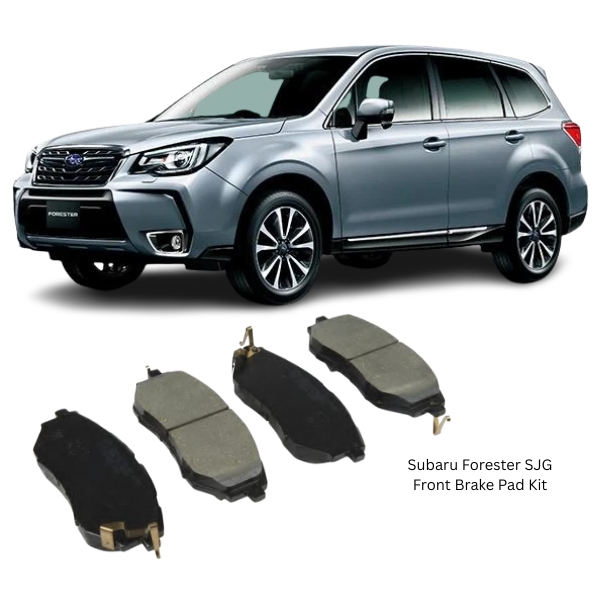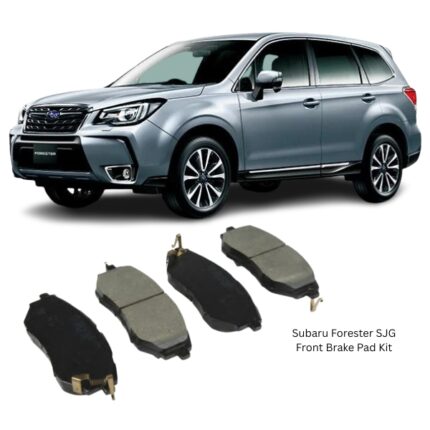Get Subaru Forester SJG Front Brake Pad Kit D7060 in Kenya
The front brake pad kit is one of the most crucial components in a vehicle’s braking system, playing an essential role in ensuring safe, efficient, and reliable stopping performance. These pads are installed in the front braking mechanism of a vehicle, typically within disc brake systems, and are engineered to create friction against the brake rotors (also known as brake discs). This friction is what allows a vehicle to decelerate and come to a complete stop when the driver presses the brake pedal.
Function and Importance
The main function of the front brake pad kit is to provide the necessary friction needed to slow down the rotation of the front wheels. As the brake calipers press the pads against the rotating brake rotors, kinetic energy is converted into thermal energy (heat), allowing the vehicle to slow down or stop. Since the front of a vehicle experiences more weight transfer during braking, front brake pads typically endure more stress and wear than rear pads. Therefore, they are often larger or made from more durable materials.
Front brake pads are critical for:
-
Stopping power: They provide most of the braking force (up to 70% in some vehicles).
-
Driving safety: Worn-out or low-quality pads can lead to longer stopping distances.
-
System protection: Good brake pads reduce excessive wear on other braking components, such as rotors and calipers.
Components of a Front Brake Pad Kit
A typical front brake pad kit includes several components designed to facilitate installation and ensure optimal performance:
-
Brake Pads (2 or 4): Usually made from friction material bonded to a metal backing plate.
-
Shim Plates: Thin metal or composite layers that help reduce noise and vibration.
-
Wear Sensors (optional): Electronic or mechanical indicators that alert the driver when pads are worn out.
-
Hardware (clips, springs, bolts): These assist in proper pad alignment and secure placement within the caliper.
-
Lubricant (brake grease): Helps reduce noise and ensure smooth operation of the moving parts.
-
Installation Instructions: Guides to help with proper assembly and torque specifications.
Construction and Material Composition
Brake pads are composed of friction material bonded to a metal backing plate. The backing plate provides structural integrity, while the friction material is designed to wear down slowly under pressure and heat. The most common types of friction materials include:
-
Semi-metallic: Made from a mixture of metals like steel or copper, combined with graphite and other fillers. These pads are durable, offer strong braking performance, and dissipate heat effectively. However, they can be noisy and may cause more wear on the rotors.
-
Ceramic: Composed of ceramic fibers, nonferrous metal fillers, and bonding agents. Ceramic pads are quieter, produce less dust, and are longer-lasting. They are ideal for everyday driving and light performance applications.
-
Organic (Non-Asbestos Organic or NAO): Made from rubber, carbon, glass, and Kevlar fibers. These pads are softer, quieter, and gentle on rotors but wear out faster and may not perform well under heavy braking conditions.
-
Low-metallic NAO: A variation of organic pads that include small amounts of metal for improved heat transfer and braking performance.
Performance Characteristics
Front brake pads must meet specific performance standards to ensure safety and effectiveness. The following factors are typically considered:
-
Friction coefficient: The ability of the pad to generate friction across various temperatures and speeds. A high coefficient of friction results in stronger braking power.
-
Fade resistance: The ability to maintain braking performance at high temperatures without becoming less effective (brake fade).
-
Noise and vibration control: Quality brake pads are designed to minimize squealing, grinding, or vibrating during braking.
-
Dust production: Some materials produce more brake dust, which can accumulate on wheels and reduce the aesthetic appeal or performance.
-
Rotor compatibility: Brake pads must be compatible with the rotors to prevent uneven wear, scoring, or damage.
Signs You Need to Replace Front Brake Pads
Knowing when to replace your front brake pads is crucial for maintaining your vehicle’s safety and braking efficiency. Common signs include:
-
Squealing or squeaking noises: Often caused by wear indicators or metal contact due to worn-out friction material.
-
Grinding sound: Indicates the pads are completely worn down, and metal is contacting the rotor.
-
Reduced braking performance: Increased stopping distances or a spongy brake pedal feel can signal worn pads.
-
Brake warning light: Some vehicles have sensors that trigger a dashboard alert when brake pads are low.
-
Vibrations while braking: Warped pads or rotors can lead to pulsating sensations during braking.
-
Visible wear: Pads can sometimes be inspected visually. If the friction material is less than 3mm thick, it’s time for replacement.
Installation and Maintenance Tips
Proper installation is essential for optimal brake performance and longevity. Here are a few maintenance and installation tips:
-
Clean the caliper and surrounding areas before installing new pads to prevent contamination and ensure proper seating.
-
Check the rotors for signs of wear or warping; resurfacing or replacing rotors may be necessary when installing new pads.
-
Apply brake grease on the backing plates and sliding components to prevent noise and ensure smooth operation.
-
Torque bolts to specification to avoid over-tightening or under-tightening, which can cause issues with brake function.
-
Perform a bedding-in process after installation by gradually applying the brakes at moderate speeds to allow the pad and rotor surfaces to mate properly.
Durability and Lifespan
The lifespan of front brake pads varies based on driving style, environment, pad material, and vehicle weight. On average, front brake pads last between 30,000 to 70,000 kilometers, though aggressive driving, city traffic, and heavy vehicles may reduce this range.
To maximize lifespan:
-
Drive smoothly and avoid hard braking unless necessary.
-
Use engine braking on descents when possible.
-
Inspect brake components regularly.
Advantages of Quality Front Brake Pad Kits
Investing in a high-quality front brake pad kit offers numerous benefits:
-
Consistent and reliable braking performance
-
Reduced noise and vibration
-
Minimized brake dust for cleaner wheels
-
Improved rotor lifespan
-
Enhanced driving safety
Low-quality or counterfeit pads may be cheaper but can compromise safety, wear out quickly, or damage other brake components.
Environmental Considerations
Modern brake pads are increasingly being manufactured with eco-friendly formulations that reduce the use of heavy metals like copper. This shift not only protects the environment (especially aquatic ecosystems) but also aligns with stricter global automotive regulations.
Proper disposal of old brake pads is also encouraged, as many contain materials that should not enter landfills. Recycling centers often accept used pads and other brake components.
Follow us on Facebook for more parts.




